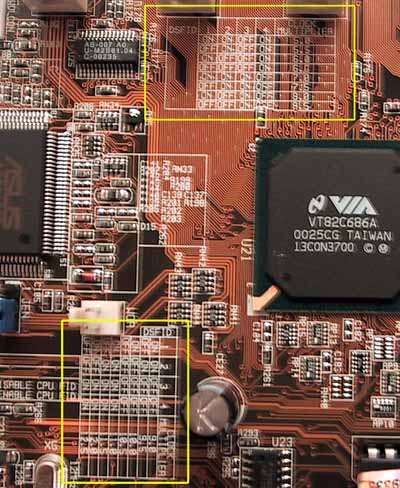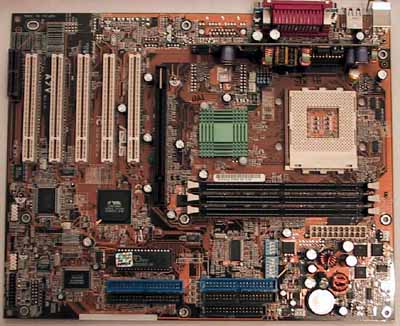Socket-A VIA KT133 Motherboard Roundup - August 2000
by Anand Lal Shimpi on August 9, 2000 12:08 PM EST- Posted in
- Motherboards
ASUS A7V
|
ASUS A7V |
|
|
CPU Interface
|
Socket-A
|
|
Chipset
|
VIA KT133
|
|
Form Factor
|
ATX
|
|
Bus Speeds
|
100
/ 103 / 105 / 110MHz
|
|
Voltages Supported
|
1.30 - 1.85V in 0.05V increments
|
|
Memory Slots
|
3 168-pin DIMM Slots
|
|
Expansion Slots
|
1 AGP Slot
5 PCI Slots (3 Full Length) 0 ISA Slots 1 AMR Slot |
|
On-board Audio
|
N/A
|
|
BIOS
|
Award Modular BIOS 6.00PG
|
ASUS continues their long string of reliable and high performing motherboards with the A7V.
First and foremost, the A7V impressed us just as much as its predecessor, the K7V, did. The board itself is laid out very similarly to the K7V, the biggest differences being that the board is a Socket-A design and features a unique vertically mounted PCB that contains a lot of the voltage regulators and capacitors that would normally be placed around the CPU socket.
The A7V features multiplier & voltage adjustment controls provided courtesy of a set of on-board dip switches and jumpers. The voltage can be controlled within the BIOS as well as on the board. Remember, that if you do plan on changing the clock multiplier on your CPU, you must make sure that all of the "Golden Bridges" at position L1 are connected; this goes for all motherboards with multiplier control.

The initial A7V boards did not have multiplier control, so if you're stuck with one of those boards, there is an excellent tutorial on how to outfit the board to allow for multiplier adjustments at Tom's Hardware. But for the most part, if you make sure that you're getting a board with the dipswitches you shouldn't have to modify your board at all.
Like some of the other KT133 boards in this roundup, the A7V also features an additional storage controller for ATA 100 support. The A7V features the same Promise PDC20265 controller that we saw on the Microstar 694D Pro which supports ATA 100 but doesn't support IDE RAID.
Since ASUS has quite a few OEMs that make use of their motherboards it isn't a surprise to see an AMR slot on the A7V, though most AnandTech readers would've rather had a 6th PCI slot take its place.
The A7V features an AGP Pro50 slot just like the K7V, but we have yet to see a card require the use of an AGP Pro50 slot for proper operation. It is a possibility that the standard may catch on in the future but for now the presence of an AGP Pro50 slot isn't really an advantage for ASUS.
Overall, the A7V is just what we have come to expect from ASUS, an extremely flexible, stable, and definitely well-made solution.












0 Comments
View All Comments